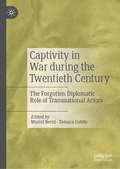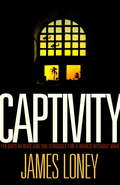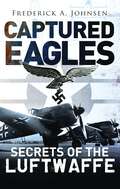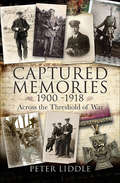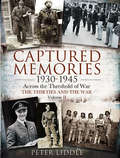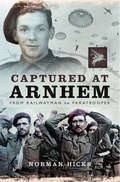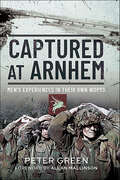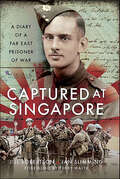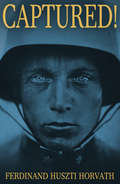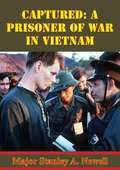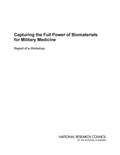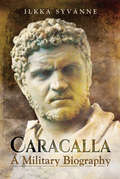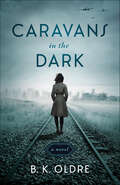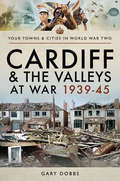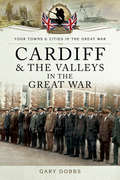- Table View
- List View
Captives: Britain, Empire, and the World, 1600-1850
by Linda ColleyIn this meticulously researched book, the author explores the phenomenon of British subjects held captive by non-European peoples between 1600 and 1850. She focuses on three arenas - the "Barbary coast" of North Africa, eastern North America, and India. During the 17th and 18th centuries, pirates from Morocco, Algiers, and other North African countries seized British ships and took captives into "white slavery." In North America and India, Britain's reach for empire led to conflict with native peoples, and British subjects were often taken captive. "Captivity narratives" became an established literary genre during this 250-year period. Colley draws upon dozens of such published accounts to bring the experience of British captives to life, and to place it in a broad historical framework.
Captivity in War during the Twentieth Century: The Forgotten Diplomatic Role of Transnational Actors
by Marcel Berni Tamara CubitoThis book offers new international perspectives on captivity in wartime during the twentieth century. It explores how global institutions and practices with regard to captives mattered, how they evolved and most importantly, how they influenced the treatment of captives. From the beginning of the twentieth century, international organisations, neutral nations and other actors with no direct involvement in the respective wars often had to fill in to support civilian as well as military captives and to supervise their treatment. This edited volume puts these actors, rather than the captives themselves, at the centre in order to assess comparatively their contributions to wartime captivity. Taking a global approach, it shows that transnational bodies - whether non-governmental organisations, neutral states or individuals - played an essential role in dealing with captives in wartime. Chapters cover both the largest wars, such as the two World Wars, but also lesser-known conflicts, to highlight how captives were placed at the centre of transnational negotiations.
Captivity: 118 Days in Iraq and the Struggle for a World without War
by James LoneyThe powerful account of the remarkable peace activist kidnapped while leading a peace delegation and held for ransom by Iraqi insurgents until his paradoxical release by a crack unit of special forces commandos.In November 2005, James Loney and three other men -- Canadian Harmeet Singh Sooden, British citizen Norman Kember and American Tom Fox -- were taken hostage at gunpoint. The men were with Christian Peacemaker Teams (CPT), an organization that places teams trained in non-violent intervention into lethal conflict zones. The then unknown Swords of Righteousness Brigade released videos of the men, resulting in what is likely the most publicized kidnapping of the Iraq War. Tom Fox was murdered and dumped on a Baghdad street. The surviving men were held for 118 days before being rescued by Task Force Black, an elite counter-kidnap unit led by the British SAS. Captivity is the story of what Jim described upon his return to Toronto and reunion with his partner Dan Hunt as "a terrifying, profound, transformative and excruciatingly boring experience." It presents an affecting portrait of how Jim came to be a pacifist and chronicles his work in Iraq before the kidnapping. It brings the reader immediately into the terror and banality, the frictions, the moral dilemmas of their captivity, their search to find their captors' humanity, and the imperative need to conceal Jim's sexual identity. It examines the paradoxes we face when our most cherished principles are tested in extraordinary circumstances and explores the universal truths contained in every captivity experience. At its heart, the book is a hope-filled plea for peace, human solidarity and forgiveness.From James Loney:Why I Wrote This BookI often wondered, during those excruciating days of handcuffs and chains, fear and boredom without end, would I ever get to tell anyone about the strange and bizarre things that happened during our captivity? Being transported in the trunk of a car. Sleeping with my left and right hands handcuffed to the person beside me. Explaining to the captors how to use "men's gel." Picking open our handcuffs after watching a Hollywood movie.It is a paradox. I went to Iraq as a pacifi st on a mission of peace and was kidnapped, threatened with death and held hostage with three other men until we were rescued in a military operation. It is an extraordinary privilege to be able to tell the story of this paradox, to explain why I remain committed to the principles of nonviolence despite the fact a member of our group was murdered and our freedom was secured by armed force. The crucible of captivity was a kind of school in which I was able to see the innermost workings of the universe, how we are all connected, how our liberation is inextricably tied together. I want to share this story in the hope of contributing to the emergence of a world without war, the single greatest challenge of the 21st century. Everything depends on this, for without peace nothing else is possible.From the Hardcover edition.
Capturada (La serie Salvada #3)
by Lorhainne EckhartEl capitán Eric Hamilton ahora está asentado en la base después de renunciar a su primer amor, el mar, por su esposa, Abby, y sus hijos. Observa día tras día cómo se despliegan sus amigos, ardiendo con la sensación de estar vacío como si la vida lo estuviera pasando, es decir, hasta que su amigo el teniente comandante Joe Reed es capturado mientras está desplegado en Irak. Mientras su familia está en casa, indefensa, la vida de Joe pende de un hilo, y Eric se ve obligado a tomar una decisión que juró que nunca volvería a tomar: si dejara a Abby y a sus hijos para ir al otro lado del mundo en busca de un amigo. quien puede estar muerto?
Captured
by Linda Goetz Holmes Roger MansellIn the years before the outbreak of the war in the Pacific, Guam was a paradise for the Navy, Marine and civilian employees of Pan American Airways, who found themselves stationed on the island. However their apprehension about the fate of the island increased as they anticipated a Japanese attack in the fall of 1941. Shortly after the attack on Pearl Harbor, Guam was bombed and the Japanese invasion soon followed.In the takeover of the island, the Japanese practiced a swift brutality against the captive Americans as well as native population, and then immediately removed the American military and civilian personnel to Japan. Only a lucky few escaped, including five Navy nurses and dependent Ruby Hellmers and her baby Charlene, who were transported back to America aboard the Swedish ship Gripsholm in mid-1942.In Captured, Mansell tells the story of the captives from Guam, whose story until now has largely been forgotten. Drawing upon interviews with survivors, diaries and archival records, Mansell documents the movements of American military and civilian men as they went from one Japanese POW camp to another, slowly starving as they performed slave labor for Japanese companies. Meanwhile, he describes the brutal horrors suffered by Guamian natives during Japan's occupation of the island, especially as the Japanese prepared for American forces to re-take this U.S. possession in 1945.Moving stories of liberation, transportation home, and the aftermath of these horrific experiences are narrated as the book draws to a close. Mansell concludes that America's lack of military preparation, disbelief in Japan's ambitions in the Pacific, and focus on Europe all contributed to the captivity of more than three years of suffering for the forgotten Americans from Guam as the Pacific War raged around
Captured Behind Japanese Lines: With Wingate's Chindits – Burma 1942–1945
by Daniel Berke"Never have I had greater respect for soldiers than those of the 14th Army who served under Bill Slim, and in particular those guys who were in the Chindit columns. They suffered hugely as they got inside enemy territory in the Burmese Jungle and as they fought against all odds; some surviving, some being captured and many dying. This book exemplifies the courage of the men who faced this ordeal." - The Rt. Hon. Colonel Bob Stewart DSO MP No-one meeting Frank Berkovitch, a quiet, reserved tailor, could have guessed that he had served with the Chindits in Burma and suffered prolonged Japanese captivity. Yet not only had he fought as a Bren-gunner on Operation LONGCLOTH, their first deep penetration mission, but he was the legendary General Orde Wingate’s batman. The Chindits were Wingate’s inspired idea and, while suffering heavy losses from enemy action and deprivation, they dispelled the myth that the Imperial Japanese Army was invincible. Outnumbered, outgunned, carrying 70lb packs and reliant on RAF air drops for supplies, the 3,000 men of the Chindit columns overcame harsh jungle terrain and climatic conditions to take the fight to the enemy behind their own lines. They wreaked havoc with enemy communications and caused heavy enemy casualties while gathering vital intelligence. After months of malnutrition and disease and hunted by the vengeful Japanese, the survivors faced a desperate race to escape from Burma. Captured crossing the Irrawaddy river, Frank endured two years imprisonment at the hands of notoriously cruel captors. Superbly researched, this inspiring book vividly describes the Chindits’ first operation and the hardship suffered by, and heroism of, Frank and his comrades, many who never returned.
Captured Eagles: Secrets of the Luftwaffe
by Frederick A. JohnsenIn Captured Eagles, Frederick A. Johnsen lays bare the once secret history of the American effort to understand and counter the Luftwaffe before and during World War II, and afterward to seize and exploit German technological advances in everything from jet fighters and bombers to ballistic missiles.Even before World War II, U.S. Army Air Force commanders were gravely concerned about the technological lead that German aviation seemed to hold. Once America entered the war, they were desperate to learn the secrets and capabilities of the Luftwaffe. From German defectors to battlefield trophies to combat action reports, the race to understand the Luftwaffe's technology took on heroic proportions. But even the end of the war didn't lessen the urgency of acquiring German technology. American intelligence teams scoured Europe to bring home the jewels of German aviation, from jet aircraft such as the Me 262 that far exceeded almost any aircraft in the Air Force's inventory, to ballistic missiles such as the V2 that were beyond anything the Allies possessed. This would be the technological foundation of American air power during the Cold War, and even give the U.S. the boost it needed to win the Space Race and land on the Moon.Drawing on rarely seen historical sources such as Air Force technical documents, as well as first person accounts from the airmen and engineers who were there, author Frederick A. Johnsen, tells the history of one of the most fascinating periods in both American and German aviation history.
Captured Memories, 1900–1918: Across the Threshold of War
by Peter LiddlePeter Liddle was a pioneer in the recording of memories of personal experience in the First World War and in the social background of those who lived through those years. Later he moved into the recording of men and women for whom the Second World War was the formative experience of their lives. In a planned two volume collection of the most outstanding interviews of the four thousand he made, for the first volume he has chosen memories which take the reader back as many as a hundred and twenty years to days in sailing ships, a Hebridean boyhood, suffragist action, pre–1914 working class life and work in the North-East of England, city life in London, service in the Boer War, pioneering a settlement in Manitoba, Canada, and the Army's experiments in the use of man-lifting kites, airplanes and balloons.The main focus of the book is upon the First World War with The Western Front battles, the Gallipoli Campaign and the Battle of Jutland prominently featured. Liddle also represents the Mesopotamian and East African fronts and women nursing under particularly unusual circumstances. Several Victoria Cross award winners and a fighter pilot ace appear, as do those whose distinction was to come later in their lives like Harold Macmillan, Henry Moore, Gordon Jacob, Emanuel Shinwell, Barnes Wallis and Victor Silvester. There is even an interview with the first conscientious objector to be court-martialed and sentenced to death before commutation of the sentence. This book is a veritable treasure trove of the past.
Captured Memories, 1930–1945: Across the Threshold of War: The Thirties and the War
by Peter LiddleIn this sequel to his successful first volume Peter Liddle brings his years of Oral History experience to the Thirties and the Second World War. He was the founder/Director of a new archive in 1999 specifically dedicated to the rescue of evidence of the Second World War which now documents the lives of more than nine thousand people in that war. Many of the most vivid recollections he has recorded covering this period appear in this book.For the Thirties poverty is movingly exemplified in recall of orphanage upbringing, labor in an East Lancashire mill and Glasgow childhood. Privileged public schools and university education is here too, with political convictions expressed by Barbara Castle and quite exceptionally by Oswald Mosley.For the War, there is a section on the sea which includes graphic detail of battle, lifeboat command, the St Nazaire Raid, and of Pearl Harbor. A George Medallist and an Admiral of the Fleet add special distinction here.For the air, a Battle of Britain Spitfire Pilot, Britains most successful night-fighter pilot, a Lancaster Bomber Pilot VC, an American pilot shot down over Belgium, surviving to fight with the Resistance, and a German Pilot retaining his national Socialist convictions present outstanding material.For the land, Dunkirk, North Africa, Italy, Singapore, D-Day, Arnhem, the Rhine Crossing, are all there but so Commando raids, SOE operations, capture, escapes, severe wounding, and a VC earned in Somaliland. A German describes the hand to hand fighting at Cassino, a Field Marshal, his service in North Africa, and Joachim Ronneberg his part in the Telemark Raid in Norway.In the Home Front section, women feature prominently was WAAF, Wrens, ATS, Bletchley Park, the Land Army, war work in factories, dance band singing, Blitz experience in several towns, war widowhood, and overseas evacuation, all feature. There is an account of bomb disposal, of the stance of a Conscientious Objector, and then four people quite exceptional for the significance of their material. Two are from Poland, a jewess who survived against all odds, and a woman who became involved in the Warsaw Uprising; the others are Sir Basil Blackwell working on the development of weaponry for the Admiralty and finally Sir Bernard Lovell on radar.This book does much to dissolve the intervening years. The essence of what is was to be young and to be there lies within these pages.
Captured Soviet Generals: The Fate of Soviet Generals Captured in Combat 1941-45
by A.A. MaslovThe true story of the fate of the captured Russian Generals after World War II, explaining how these officers endured horrific prison conditions and were then tried and executed when they returned home.
Captured at Arnhem: From Railwayman to Paratrooper
by Norman HicksA memoir of a young soldier&’s training as a paratrooper during WWII, his wartime service, imprisonment and return to his career for the British railways. After spending the 1930s working for the London Midland Scottish railways, Tom Hicks volunteered for war service in 1939 and was initially placed in the military railway of the Royal Engineers. In search of adventure, he successfully applied to join the newly formed 1st Parachute Squadron of the Royal Engineers. The intensity and rigors of parachute training are described in detail, as are the comradeship and humor that came to the fore as this small 150-man unit fought throughout the Second World War as part of the 1st Parachute Brigade. The excitement of the first parachute jumps is relived together with the parachute operations in North Africa, Sicily, and the Battle of Arnhem. It was here after nine days&’ fighting with his mates falling around him that Tom was wounded and taken prisoner. Following the battle, Tom was transported in a cattle truck to Germany where he was used as forced labor in a lead mine until being liberated by the Americans in 1945. With insightful commentary from Tom&’s son Norman, this is the story of an ordinary soldier, who was motivated by pride in his unit. Tom has recounted his experiences with a keen eye and a sense of humor that has always enabled him to triumph in the face of adversity.
Captured at Arnhem: Men's Experiences in Their Own Words
by Peter GreenFor the British 1st Airborne Division Operation Market Garden in September 1944 was a disaster. The Division was eliminated as a fighting force with around a half of its men were captured. The Germans were faced with dealing with 6,000 prisoners in a fortnight; many of them seriously wounded. Somehow the men were processed and despatched to camps around Germany and German occupied eastern Europe. Here the men experienced the reality of the collapsing regime – little food and shrinking frontiers. Once liberated in 1945 returning former prisoners were required to complete liberation questionnaires. Some refused. Others returned before ’Operation Endor’ to handle released men and their repatriation to Britain was in place. Around a third did. However the questionnaires that do exist give an picture of every day experience for the 2,357 of these elite troops’ time in captivity from capture to release. They show that German procedures still operating, but that men were often treated inhumanely, when moved to camps by closed box cars and when camps were evacuated. Although their interrogators were interested in Allied aircraft and airfields, their interrogators were also concerned the effect of the new miracle weapons and with politics, how Germany would be treated after an Allied victory? Nevertheless the airborne men’s morale remained high; carrying out sabotage at artificial oil plants, railway repairs, factories and mines. Some overcame their guards when being evacuated at the end of the War, in some cases joining the Resistance. They record help received from Dutch, French and German civilians.
Captured at Kut, Prisoner of the Turks: The Great War Diaries of Colonel W C Spackman
by Colonel R A SpackmanThis edited diary is Colonel Bill Spackmans extraordinary personal record of his experiences as the Medical Officer of an Indian Infantry battalion during the Mesopotamian Campaign 1914 1916. In particular he describes the harrowing events of the five month siege of Kut and, after the surrender of the 10,000 strong garrison in April 1916, the hardships of the 1,000 mile forced march to Anatolia in Turkey. As a doctor he witnessed at first hand suffering the and deaths of many POWs, both British and Indian.The book goes on the record life in Turkish captivity which was relatively relaxed and fortunately, in sharp contrast to their earlier experiences.Written with humorous understatement and infinite good sense Captured at Kut : Prisoner of the Turks is a gripping read and will appeal strongly not just to Great War enthusiasts but all who enjoy reading of the triumph of men over extreme adversity.
Captured at Singapore: A Diary of a Far East Prisoner of War
by Jan Slimming Jill RobertsonWhat would it be like to leave your loved ones behind knowing you may never see them again? Then depart on a ship in the dead of night heading for an unknown destination and find yourself in the heat of a battle which concludes in enemy conditions so terrible that your survival in captivity is still under threat? Cultivated from a small, faded, address book secretly written by a young soldier in the Royal Army Service Corps, Captured at Singapore, is a POW story of adventure, courage resilience and luck. In 1940, Londoner Stanley Moore became Driver T/170638 and trained for desert warfare along with many others in the British Army’s 18th Division. Their mission, they thought, was to fight against Hitler and fascism in the Middle East. But in a change of plan and destination, he and his fellow servicemen became sacrificial lambs on a continent much further from home. After tough rudimentary combat training in England, Stan’s division set off on a secret overseas mission. After months at sea, and several unexpected ports of call, their convoy was redirected to the other side of the world as the Imperial Japanese Army rampaged across Manchuria, Hong Kong and other parts of Asia. Singapore was under sole British jurisdiction and a large naval base had been built after the First World War to defend the island at the foot of the Malay Peninsula. The British Government believed Japan would never attack their prize territory and so left Singapore to fight for itself with limited troops and outdated equipment. But after an attack on Pearl Harbor, the under-trained and undersupplied 18th Division was redirected to fight the Japanese. Using extensive research and personal documents, the authors’ account - via their father’s small, faded, diary and his 1990 tape recording - tells of Stan’s journey and arrival in Keppel harbor under shellfire; the horrific 17 day battle to defend the island, the Japanese Admonition and the harrowing forced labour conditions after capitulation. Only a small percentage of the 85,000 British troops returned after the war. Captivity and years of trauma ultimately stole years of the young soldiers’ lives, which they were later ordered to forget by the British Government. The aim of this work is to provide information for future generations to understand how ordinary men died under horrific conditions of war, and how the lucky survived.
Captured at the Imjin River: The Korean War Memoirs of a Gloster
by David GreenThe author, a young conscript, fought with The Glorious Glosters at the legendary Imjin River battle. Heavily outnumbered by the Chinese and subjected to 'human-wave' infantry attacks, he and his colleagues suffered the trauma of being overrun and the vast majority of those who were not killed became POWs. This serious reverse of fortunes shocked postwar Britain but the bravery of the Battalion caught the public's imagination. The inhuman treatment suffered at their captors' hands by the survivors, including the author, has possibly never been fully realized. This memoir written from the perspective of a fighting soldier will surely bring home some most unpalatable truths.
Captured by Her Enemy Knight (Lovers and Legends #9)
by Nicole LockeCaptured by her enemy…Falling for the manCressida Howe, the Archer, is a well-tuned weapon. But she’s also a woman captivated by a man—Eldric of Hawskmoor, the warrior knight her father ordered her to kill. Instead, for years, Cressida has simply watched him… Now she’s been captured by her formidable enemy, and her well-ordered world comes crashing down, for Eldric is even more compelling up close. Cressida curses her traitorous heart—this assassin has fallen for her target!“Secrets of a Highland Warrior is romantic, engaging and has a wonderful depth that kept me invested in both the characters and story! I didn’t want it to end!”—Rae Reads, Book Blog on Secrets of a Highland Warrior“Ms Locke’s passion for this era and this story is evident on every page. I cannot wait to see what comes next.”—Chicks, Rogues and Scandals on Reclaimed by the Knight
Captured!
by Ferdinand Huszti HorvathCaptured!, first published in 1930, is the dramatic World War I account of Ferdinand Huszti Horvath (1891-1973), who served in the Austro-Hungarian army on the eastern front in the bitter fighting against the Russians. Horvath paints a realistic picture of combat and the miserable conditions in the frontlines. Later, Horvath is captured by Russian troops and imprisoned for 2-1/2 years. After escaping from the prison camp and a hazardous journey across Russia (then in the throes of the turbulent Communist revolution), he made his way to freedom in Sweden. The book ends at that point in Hovarth's life, but he would go on to emigrate to America, working as an animator for Disney and other Hollywood studios.
Captured: A Prisoner Of War In Vietnam
by Major Stanley A. NewellThis monograph is a personal account of the author's experiences as a prisoner of war. Major Newell was a 19-year old Army Enlisted Infantry man when captured in South Vietnam in 1967. His purpose is to provide his first impressions upon capture, relate his experiences, and provide lessons learned. His conclusion: long-term captivity is survivable.This monograph is based on personal experiences and memory of events.
Capturing the Complexity of Conflict: Dealing with Violent Ethnic Conflicts of the Post-Cold War Era
by Dennis J. SandoleFirst Published in 1999. Routledge is an imprint of Taylor & Francis, an informa company.
Capturing the Full Power of Biomaterials for Military Medicine: Report of a Workshop
by Committee on Capturing the Full Power of Biomaterials for Military Medical NeedsRecent results in biomaterials R&D suggest that there are exceptional opportunities for these emerging materials in military medicine. To facilitate this possibility, the National Research Council convened a workshop at the request of the Department of Defense to help create a technology development roadmap to enhance military R&D into biomaterials technology. The workshop focused primarily on identifying useful near- and mid-term applications of biomaterials including wound care, tissue engineering, drug delivery, and physiological sensors and diagnostics. This report presents a summary of the workshop. It provides a review of biomaterials and their importance to military medicine, the roadmap, and a discussion of ways to enable biomaterials development. Several important outcomes of successful capture of potential benefits of these materials are also discussed.
Capturing the Women's Army Corps: The World War II Photographs of Captain Charlotte T. McGraw
by Francoise Barnes Bonnell Ronald Kevin BullisThe photographs taken by Charlotte T. McGraw, the official Women&’s Army Corps photographer during World War II, offer the single most comprehensive visual record of the approximately 140,000 women who served in the U.S. Army during the war. This collection of 150 of McGraw&’s photos includes pictures made in Africa, in England at the headquarters of the European Theater of Operations, in Asia and the Pacific, and in military hospitals in the United States.Serving from July 1942 to August 1946, Captain McGraw provided more than 73,000 photographs to the War Department Bureau of Public Affairs. Her photographs were published in the New York Times, New York Herald Tribune, and used by the Associated Press and the United Press, as well as in recruiting posters, handouts and informational pamphlets, and in the most popular magazines of the era such as Time, Colliers, Women&’s Home Companion, Parade, Saturday Evening Post, and Mademoiselle.
Caracalla: A Military Biography
by Ilkka SyvänneThis biography of the Roman Emperor Caracalla challenges his tyrannical reputation with a revealing narrative of his social reforms and military campaigns. Caracallahas one of the worst reputations of any Roman Emperor. Many ancient historians were very hostile, and the 18th century English historian Edward Gibbon even dubbed him the common enemy of mankind. Yet his reign was considered by at least one Roman author to be the apogee of the Roman Empire. He was guilty of many murders and massacres—including that of his own brother, ex-wife and daughter. Yet he instituted the Antonine Constitution, granting citizenship to all free men in the Empire. He was also popular with the army, improving their pay and cultivating the image of sharing their hardships. Historian Ilkka Syvanne explains how the biased ancient sources in combination with the stern looking statues of the emperor have created a distorted image of the man. He then reconstructs a chronology of Caracalla&’s reign, focusing on his military campaigns and reforms, to offer a balanced view of his legacy. Caracalla offers the first complete overview of the policies, events and conflicts he oversaw and explains how and why these contributed to the military crisis of the third century.
Caravans in the Dark: A Novel
by B. K. OldreFifteen-year-old Jana’s Romani family leads a nomadic life, traveling and trading horses, in Czechoslovakia. When her family relocates to Prague one step ahead of the Nazi invasion, Jana becomes a freedom fighter. She gets a job in the Prague castle, where secret messages are hidden inside of clocks and she must smuggle them out of the castle and pass them on to the Resistance.After the Nazis close all Czech colleges and universities, Jana and two of her peers—her Resistance contact, Otto, who was the first in his family to attend college, and a fellow student, Albert—are even more determined to free their country from the Nazi oppressors. All three will face danger and desperate choices as they learn that this fight will cost them more than they ever imagined.In this coming-of-age story set in extraordinary times, Jana and her friends strive to find love and their place in the world—even as they fight the Nazi occupation of their country.
Cardiff and the Valleys at War, 1939–45 (Your Towns & Cities in World War Two)
by Gary DobbsWhen Britain declared war on Germany on 3 September 1939, Cardiff and its surroundings, like every other city, town, hamlet and village in the country, sent forth large numbers of young men to fight against the oppression of Hitler and the Nazis. This is a story not only of the war itself, but of the way war affected those far away from the battlefields, and of how a nation stood together in the face of a seemingly unstoppable force.The book pays particular attention to the way Welsh society changed during the war years, far reaching changes that are still felt in the country today. The book details the enormity of the human sacrifice paid by the people of Cardiff and its surrounding areas, but also contains many examples of the way ordinary people stood proud, defiant in their determination to bring about the downfall of the Nazis. Lavishly illustrated with over fifty original and modern-day photographs, this book is essential reading for anyone interest in military and social history.
Cardiff and the Valleys in the Great War
by Gary DobbsLooks at the Cardiff Pals and other local regiments who fought in the Great War and how the experience of war impacted on the area, from the initial enthusiasm for sorting out the German Kaiser in time for Christmas 1914, to the gradual realization of the enormity of human sacrifice the families of Cardiff were committed to as the war stretched out over the next four years. An important place for Coal export this book looks at how the balance between working and fighting was achieved by the Dockyard workersThe Great War affected everyone. At home there were wounded soldiers in military hospitals, refugees from Belgium and later on German prisoners of war. There were food and fuel shortages and disruption to schooling. The role of women changed dramatically and they undertook a variety of work undreamed of in peacetime. Meanwhile, men serving in the armed forces were scattered far and wide. Extracts from contemporary letters reveal their heroism and give insights into what it was like under battle conditions.

